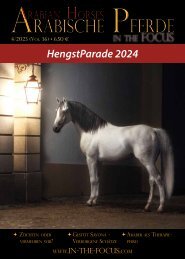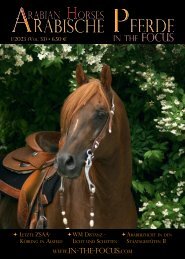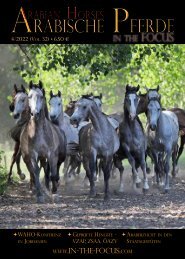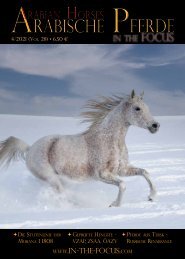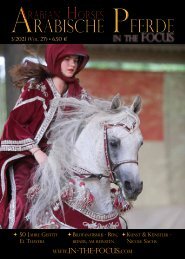Arabische Pferde IN THE FOCUS Nr. 2/2019 - Preview
Zeitschrift für Liebhaber arabischer Pferde
Zeitschrift für Liebhaber arabischer Pferde
Sie wollen auch ein ePaper? Erhöhen Sie die Reichweite Ihrer Titel.
YUMPU macht aus Druck-PDFs automatisch weboptimierte ePaper, die Google liebt.
Fatigue damage in the fetlock of a racehorse is similar to fatigue damage in other materials such<br />
as metal. - Ermüdungsschäden im Fesselgelenk eines Rennpferdes ähneln den Ermüdungsschäden<br />
in anderen Materialien wie Metall.<br />
should be avoided during this period.<br />
As we refine these models we will trial variations<br />
of training intensity to better mirror actual<br />
racehorse training programs so that we<br />
can make more specific recommendations.<br />
In the meantime trainers need to be cautious<br />
in returning horses to work too rapidly if they<br />
have been rested from training for longer<br />
than a week.<br />
The Importance of Rest Periods<br />
Race horses need periods of time away from<br />
the rigours of racing and race training to<br />
stay at their peak. Spells from racing are<br />
essential to maintain bone and joint health<br />
because when horses are racing at their<br />
peak, bone repair is inhibited and so bone<br />
damage accumulates. However during rest<br />
periods the bone repair processes are activated<br />
allowing removal of damaged bone<br />
and replacement with new bone. Periods of<br />
rest from training are therefore essential to<br />
prolong the career of race horses.<br />
The obvious question then is how much<br />
training is too much and how much rest is<br />
needed to maintain bone damage at safe<br />
levels. As with all biological questions this<br />
is difficult to answer for a particular horse<br />
because of the large variation between individual<br />
animals. However, based on the high<br />
incidence of joint injury in race horses it is<br />
reasonable to assume that most horses are<br />
not getting enough time away from training<br />
to allow adequate bone repair.<br />
Although the racing calendar makes it difficult<br />
to increase time off training, finding an<br />
extra few weeks in the paddock each year for<br />
rest and recovery will mean fewer injuries<br />
that could have forced an unplanned rest or<br />
even retirement.<br />
Rest Periods for Joint Injury<br />
Veterinarians commonly recommend rest<br />
periods for horses with injuries or lameness<br />
problems. This can be challenging for owners<br />
and trainers to accept due to the expense<br />
of keeping horses during rest periods and<br />
training when they are not earning money<br />
on the track. So it’s important to understand<br />
the purpose of rest.<br />
For joint injuries the goal is to allow the<br />
bone underlying the cartilage to heal and<br />
for inflammation to subside. Provided there<br />
is no ongoing irritation or damage, soft tissue<br />
inflammation settles in about six weeks.<br />
For bone, the traditional three month healing<br />
period is based on data from experimental<br />
animals. However in our studies on<br />
the horse, after three months only 16% of<br />
the bone under cartilage will be replaced<br />
suggesting that much longer periods of rest<br />
might be necessary. We have also seen that<br />
when microscopic damage is extensive the<br />
healing cells are unable to gain access to<br />
the injured area and this further delays the<br />
healing time.<br />
Failing to allow adequate time for a joint injury<br />
to repair will result in greater stress on<br />
the remaining healthy joint surface and an<br />
increased risk of arthritis and pain developing.<br />
Horses’ joints routinely experience extreme<br />
loads when galloping so there is little<br />
scope for the uninjured portion of a joint<br />
surface to cope with greater loads. That’s<br />
why horses with joint injury fail to perform<br />
to expectations for the remainder of their<br />
careers. The short term gain of getting a horse<br />
back to racing earlier after an injury may<br />
be offset by substandard performance and a<br />
shortened career.<br />
So in summary injury prevention in racehorses<br />
involves:<br />
• Allowing time for the skeleton to adapt<br />
to galloping when training is first introduced<br />
or when it is reintroduced after a<br />
rest period.<br />
• Minimising the accumulation of bone<br />
damage by avoiding intense training and<br />
racing campaigns. This can be achieved<br />
by reducing the distance of galloping<br />
workouts and spacing races by three to<br />
four weeks.<br />
• Scheduling regular spells from intense<br />
training.<br />
• If injury does occur follow your veterinarian’s<br />
recommendations on the appropriate<br />
period of rest from training, and<br />
ensure that the preparation for return to<br />
racing is gradual.<br />
Dr R Chris Whitton,BVSc, PhD, FACVSc<br />
Head of the Equine Centre, Professor of<br />
Equine Medicine and Surgery, Specialist<br />
in Equine Surgery, The University of<br />
Melbourne, Australia<br />
The number of cycles of load to failure: The higher the speed (the faster) the earlier bone fatigue<br />
may occur (fewer strides). - Die Anzahl der Belastungszyklen bis zum Versagen: Je höher die<br />
Geschwindigkeit, desto früher kann eine Knochenermüdung auftreten.<br />
Science<br />
2/<strong>2019</strong> - www.in-the-focus.com<br />
63



